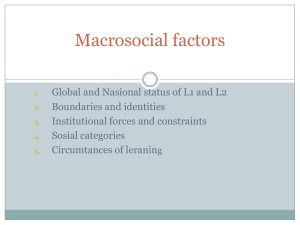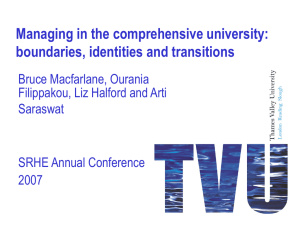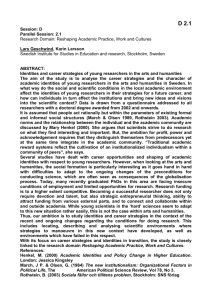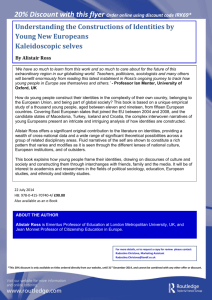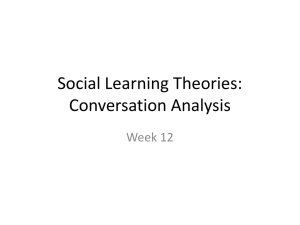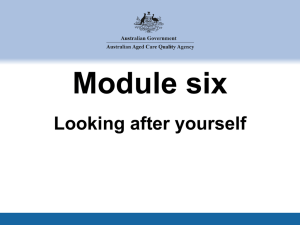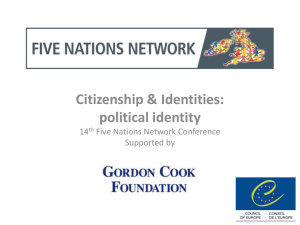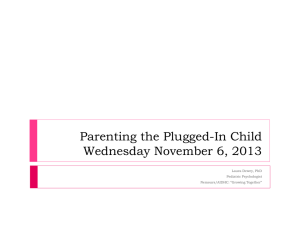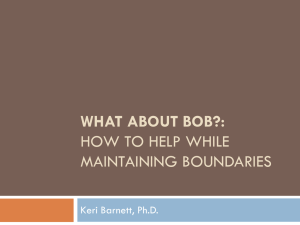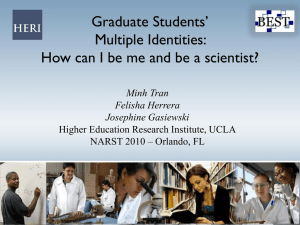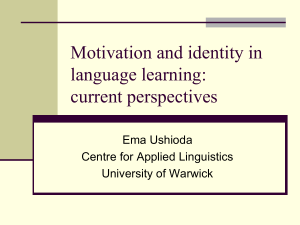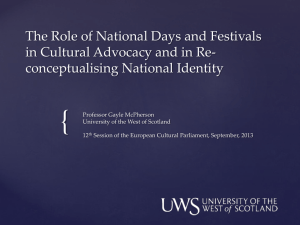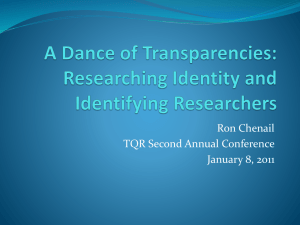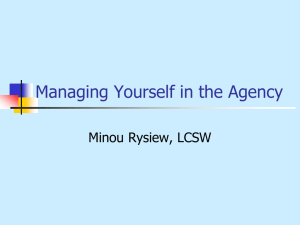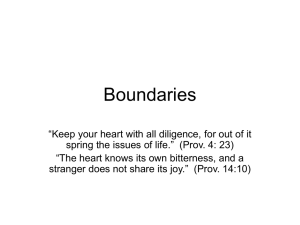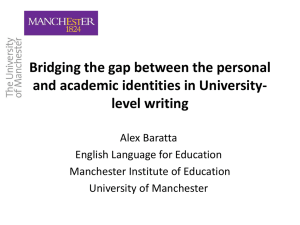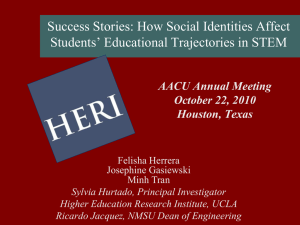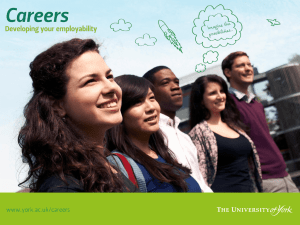New Learning Professionals: Shifting roles and blurring
advertisement
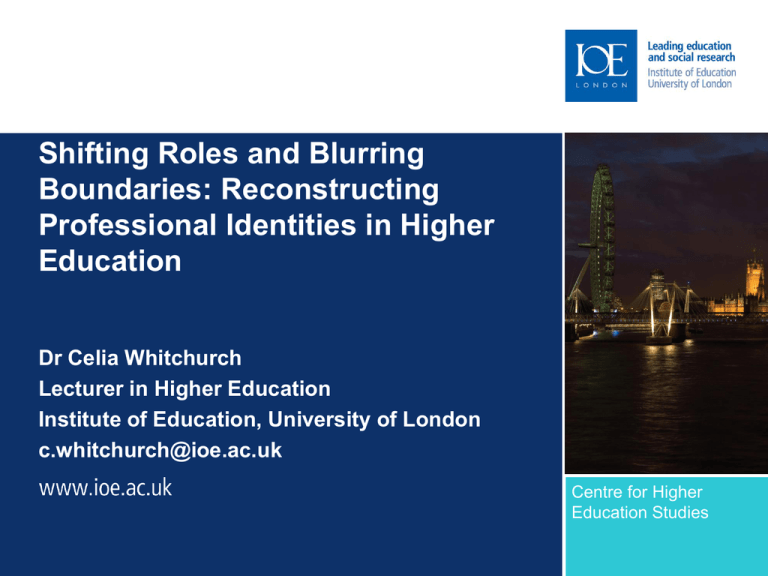
Shifting Roles and Blurring Boundaries: Reconstructing Professional Identities in Higher Education Dr Celia Whitchurch Lecturer in Higher Education Institute of Education, University of London c.whitchurch@ioe.ac.uk Centre for Higher Education Studies Contexts I • Study for LFHE on changing roles and identities of professional staff (www.lfhe.ac.uk/publications/research) • Literature on academic identity • Limited understandings about professional staff identities… • Focus on professional managers (as opposed to academic managers) 2 Contexts II • Practitioner literature highlighted: – ‘Professionalisation’ eg accreditation; CPD; code of standards – Increased specialisation to deal with eg legislative, audit and market requirements •Neglect of: – Diversity and mobility of professional staff – Blurring of organisational/functional/professional boundaries – Emergence of partnership working • ‘Professionalisation’ process and greater fluidity 3 happening simultaneously Conceptual framework (identity) •Conceptual framework of identity: A reflexive process or project requiring the active participation of the individual The way that individuals position themselves in relation to eg organisation charts/structures Interpretation of positioning in relation to others •Therefore, an ongoing, open-ended process (rather than fixed core/belonging), plus •Possibility of multiple aspects or dimensions 4 The study •29 interviews in UK •Three institutions (multi-faculty, green-field campus, post1992) •Middle and senior career professionals: – Generalists eg registry staff, departmental managers – Specialists eg finance, human resources – ‘Niche’ managers eg quality, widening participation, research management •Further interviews in Australia (one sandstone, one postmerger institution: 10 interviews) and US (two public institutions: 15 interviews) 5 Key findings I •Professional identities more complex than implied by eg job descriptions/organisation charts •People distinguish themselves by the way that they operate around organisational boundaries 6 Identity ‘Dispositions’ Identity Dispositions Characteristics ‘Bounded professionals’ (voluntary or involuntary) Work within clear structural boundaries (eg specialist function, organisational location, job description) ‘Cross-boundary professionals’ Actively use boundaries and crossboundary knowledge for strategic advantage and institutional capacity building ‘Unbounded professionals’ Lack of awareness of boundaries; focus on broadly-based projects across the university, and contribute to institutional development ‘Blended professionals’ Dedicated appointments spanning professional and academic domains; likely to have mixed backgrounds and academic credentials 7 Typology of identities Activity dimensions Spaces Knowledges Relationships Legitimacies 8 Characteristics of Bounded Professionals Characteristics of Crossboundary Professionals Characteristics of Unbounded Professionals Characteristics of Blended Professionals Key findings II •Also found evidence that: The boundary between professional and academic domains is becoming increasingly blurred A ‘third space’ is emerging between the two 9 The Emergence of ‘Third Space’ Professional Staff Generalist functions (eg registry, department/ school management) ‘Perimeter’ roles eg Outreach/study skills Specialist functions (eg finance, human resources) Access/equity/ disability ‘Niche’ functions (eg quality, research management Community/ regional partnership 10 Examples of Institutional Projects The Student Transitions Project eg Life and welfare Widening participation Employability and careers The Partnership Project eg Regional/community development Regeneration Business/technology incubation The Professional Development Project eg Academic practice Professional practice Project management Leadership/management development Multi-functional teams “The Higher Education Professional” ‘Perimeter’ roles eg Academic Staff Pastoral support Teaching/ curriculum development for non-traditional students Links with local education providers Teaching Research ‘Third leg’ eg public service, enterprise Implications of Third Space I •Team working between: – people of different levels of seniority – different specialist and professional backgrounds •Authority built on personal basis, rather than solely via position in hierarchy or specialist knowledge: – “There’s no authority that you come with” – “It’s what you are, not what you represent” – “If you solve a problem for us, we’ll come back and work with you again” 11 Implications of Third Space II •Ambiguous working conditions – “Sometimes an academic unit, sometimes an office” •Using this to advantage •Developing appropriate language •Assisted by eg: – Availability of ‘safe space’ in which to experiment – Support of senior figure or mentor (HOA, PVC) – Acquisition of academic credentials (master’s, doctorates) 12 Implications of Third Space III •Diffusion of ‘management’ and ‘leadership’ •No longer ‘done’ by one sub-set of people to majority •Likely to involve: – Management/leadership skills at earlier stage of people’s careers – Bringing together local practice and formal frameworks – Being creative with existing mechanisms 13 Challenges of Third Space •For individuals: –Status of boundary work? –How to gain credit for third space activity in appraisal/promotion processes? –Risks in getting out of ‘mainstream’? –Inappropriate reporting lines… –Networking vs formal relationships eg committee membership 14 Challenges of Third Space •For institutions: –Sources of leverage can be diffuse –How to prevent eg projects developing a life of their own; or being too dependent on one individual –Encouraging creativity/innovation while maintaining oversight… –Lines of communication… –Appropriate mix/balance of identities 15 The future? • Changing concepts of ‘professionalism’…? • ‘Millennial' generation expect: – Flexibility, creativity, lifestyles, locations – Less elitism – New locales for activity eg outreach – Portfolio careers – Networking – Sharing of good practice… • A genuine ‘community of professionals’? (See Richard Florida – The Rise of the Creative Class, 2002) 16
